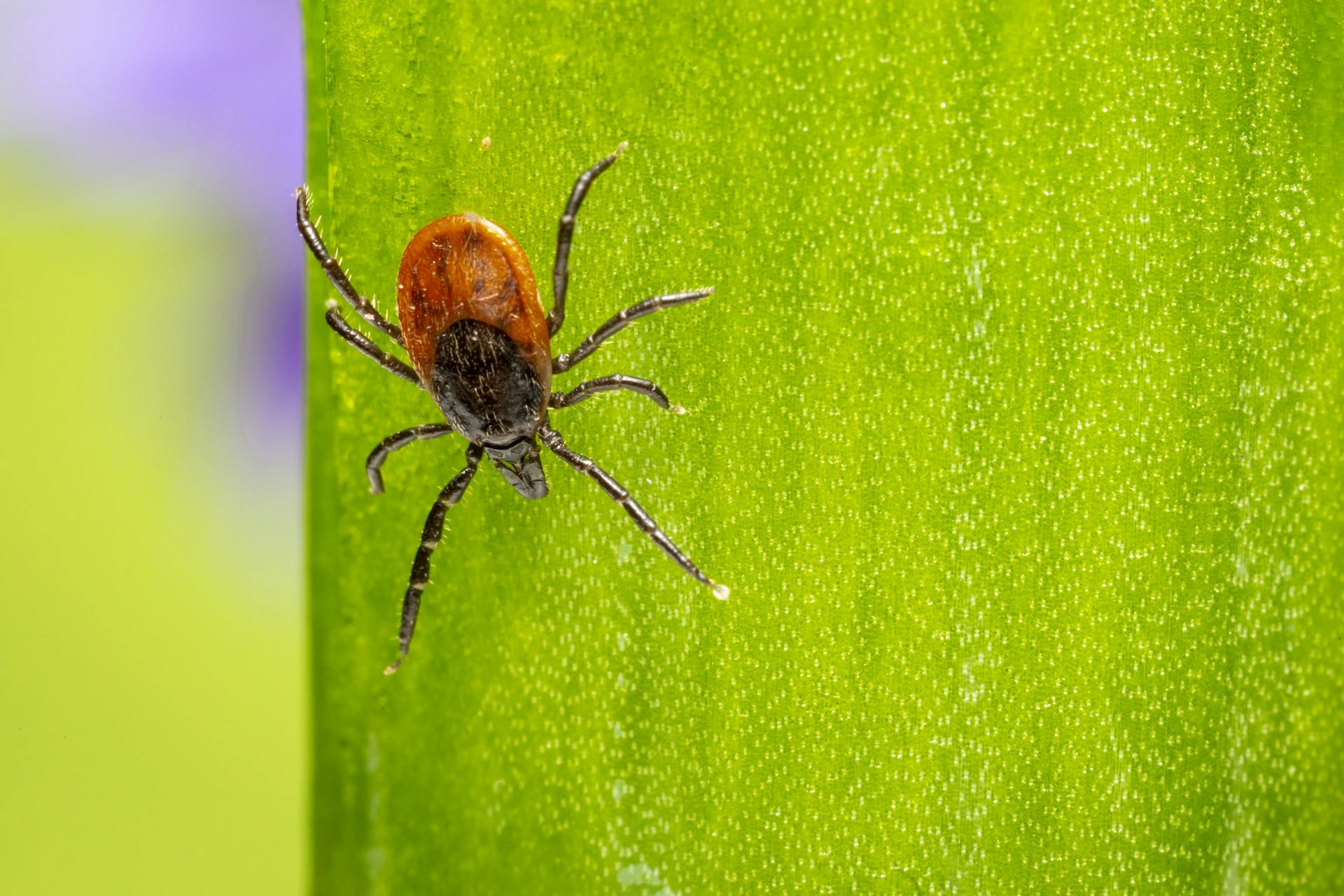
Fleas and ticks can be a real nuisance for dogs, causing discomfort, skin irritation, and even serious health issues like anemia and diseases like Lyme disease.
Dogs that spend time outdoors, especially in areas with tall grass and wooded areas, are more likely to get fleas and ticks.
Some dogs, like those with weakened immune systems or taking certain medications, may be more susceptible to flea and tick infestations.
Flea and tick medicine can be an effective way to prevent and treat infestations, but it's not always necessary for every dog.
Readers also liked: How to Keep Ticks off a Dog?
Prevention Methods
Using spot-on flea and tick prevention is a common approach, but it's essential to choose the right one for your dog.
You'll want to opt for spot-ons with the fewest ingredients to minimize the risk of toxins.
Fipronil, a broad-spectrum insecticide, disrupts the insect's central nervous system, causing hyperexcitation of its nerves and muscles.
Imidacloprid, another active ingredient, acts as an insect neurotoxin to attack the central nervous system of sucking pests like fleas.
Permethrin and Pyriproxyfen are also used in spot-ons, but they're not as effective as some of the other ingredients.
Some spot-ons contain Moxidectin, which is toxic to honeybees and mimics the effects of nicotine on insects.
Dinotefuran and (S)-methoprene are also used in some spot-ons, but it's essential to understand their effects on pests.
Selamectin is a versatile ingredient that treats heartworms, fleas, ear mites, and sarcoptic mange in dogs.
Here are some common active ingredients found in spot-on flea and tick preventatives:
- Fipronil: disrupts the insect's central nervous system
- Imidacloprid: acts as an insect neurotoxin
- Permethrin: used to treat lice
- Pyriproxyfen: not as effective as other ingredients
- Moxidectin: toxic to honeybees and mimics nicotine effects
- Dinotefuran: neuro-active insecticide
- (S)-methoprene: stops growth and development
- Selamectin: treats heartworms, fleas, ear mites, and sarcoptic mange
Oral Preventatives
Oral preventatives are a popular choice for dog owners, but it's essential to understand how they work and what's inside them. Isoxazolines, like afoxalaner, fluralaner, sarolaner, and lotilaner, work systemically, meaning they're absorbed into your dog's blood and affect the entire body.
These chemicals are potent and can be poisonous to ticks and mites. Some oral preventatives also contain antiparasitic chemicals, or dewormers, which are used to treat internal parasites like worms.
Some popular oral preventatives include NexGard for Dogs and NexGard SPECTRA for Dogs, which are soft, tasty beef-flavoured chews that dogs love. They don't need to be given with food and can be administered at any time.
Worth a look: Does Dog Flea Shampoo Work
Medicated Hair Care

Medicated hair care products, like medicated flea and tick shampoos and sprays, contain harmful chemicals that can expose your dog to more toxins.
These products contain active ingredients like Permethrins, which we've already discussed, as well as Piperonyl Butoxide and N-Octyl bicycloheptene dicarboximide, which work together to increase the effectiveness of pesticides.
Giving your dog a medicated flea and tick shampoo bath won't provide any benefits, and it's actually not necessary. A bath with a shampoo made of natural ingredients will drown fleas just as effectively.
PRO TIP: If your dog has fleas, don't forget to treat your home and yard for fleas, as well as your dog.
Expand your knowledge: Tick Shampoo
Oral Preventatives Work
Oral preventatives work by being absorbed into your dog's blood and affecting the entire body. This means that when fleas and ticks feed on your dog's blood, they ingest the chemicals and become paralyzed, eventually dying.
Isoxazolines are a class of active ingredients used in oral flea and tick preventatives that work systemically. These include afoxalaner, fluralaner, sarolaner, and lotilaner, all of which are members of the isoxazoline family.
A different take: Dog Dental Work
Fleas and ticks can be killed within 6-8 hours of product administration with oral preventatives like NexGard for Dogs. Regular monthly treatment is recommended to keep your pet and home flea-free.
If you're looking for a flea preventative for your dog, be sure to check the label for active ingredients like afoxalaner, fluralaner, sarolaner, and lotilaner. These ingredients are effective against fleas and ticks.
Here are some active ingredients to watch out for in oral flea and tick preventatives:
- Afoxalaner – a member of the isoxazoline family
- Fluralaner – for systemic use and also a member of the isoxazoline family
- Sarolaner – an acaricide and insecticide also belonging to the isoxazoline family
- Lotilaner – an ectoparasiticide belonging to the isoxazoline family
Remember that while oral preventatives can be effective, they can also have side effects, especially if given in combination with dewormers. Always consult with your veterinarian before starting any new treatment.
Spot-On Side Effects
Spot-on flea and tick preventatives can cause a range of side effects in dogs and humans. Skin reactions like hair loss, itching, and redness are common clinical signs in dogs.
Fipronil, a common active ingredient in spot-ons, can enter a dog's body and be stored in fat, organs, urine, and feces. This can lead to systemic disorders.
Imidacloprid has caused skin irritation in pet owners after applying spot-on products to their animals. It's also toxic to honeybees and mimics the effects of nicotine on insects.
Higher doses of (S)-methoprene in dogs can cause skin irritation. Brief exposure to this ingredient can cause mild or moderate skin irritation in humans.
The most common side effects of spot-ons include skin reactions, dermatitis, sores, irritation, and hair changes at the application site.
A fresh viewpoint: Dog Flea Collar Side Effects
Spot-On Products
Spot-on products are a common type of flea and tick prevention that are applied directly to your dog's skin. They're usually dropped onto specific spots along your dog's back.
The active ingredients in spot-on products can be a concern, as some can disrupt an insect's central nervous system or act as insect neurotoxins. Fipronil, for example, can be toxic to honeybees and mimics the effects of nicotine on insects.
Some spot-on products contain multiple active ingredients, which can increase the risk of side effects. If your dog isn't infested with multiple pests, it's best to use products with fewer ingredients.
Additional reading: Dog Flea Medicine Side Effects
Common side effects of spot-on products include skin reactions, hair loss, itching, and redness, as well as neurological issues like uncoordinated movement and lethargy.
Here are some common active ingredients found in spot-on products:
- Fipronil: a broad-spectrum insecticide that disrupts an insect's central nervous system
- Imidacloprid: a systemic insecticide that acts as an insect neurotoxin
- Permethrin: a synthetic version of pyrethrin, which is toxic to fish and other aquatic animals
- Moxidectin: a macrocyclic lactone that paralyzes and kills insects
- Dinotefuran: a neonicotinoid insecticide that's chemically similar to nicotine
- (S)-methoprene: an insecticide that stops growth and development, preventing pests from reproducing
- Selamectin: an antiparasitic and antihelminthic insecticide used to treat heartworms, fleas, and other parasites
Keep in mind that some of these ingredients can also cause side effects in humans, such as skin irritation and allergic reactions.
Frequently Asked Questions
What months do dogs need flea and tick medicine?
Dogs typically need flea and tick medicine from September to November, as these months are considered peak seasons for flea and tick activity. Applying preventative measures during this time can help reduce the risk of infestation.
When can I stop giving my dog flea and tick medicine?
Stop flea and tick medicine when the ground freezes, as this typically indicates the pests are no longer active outdoors. However, indoor flea populations can persist year-round, so ongoing treatment may still be necessary.
What are the pros and cons of flea and tick medication?
Flea and tick medication is generally safe and effective, but may take 24 hours to fully spread, leaving an oily spot on the pet's hair. It kills fleas and ticks without requiring them to bite the pet first.
Sources
- https://www.petcgfk.com/fleas-tick-heartworm-prevention/
- https://www.petsmart.com/dog/flea-and-tick/
- https://www.dogsnaturallymagazine.com/new-fda-warning-about-flea-and-tick-medications/
- https://nwveterinarian.com/tick-prevention-best-dog/
- https://nexgard.com.au/dog-parasites/fleas/flea-treatment-for-dogs
Featured Images: pexels.com


